Inappropriate Nurse to Patient Staffing Ratios in Australia: A Review of Current Policies and Recommendations for a Single National Strategy
Added on 2023-04-22
27 Pages9324 Words89 Views
Health Project
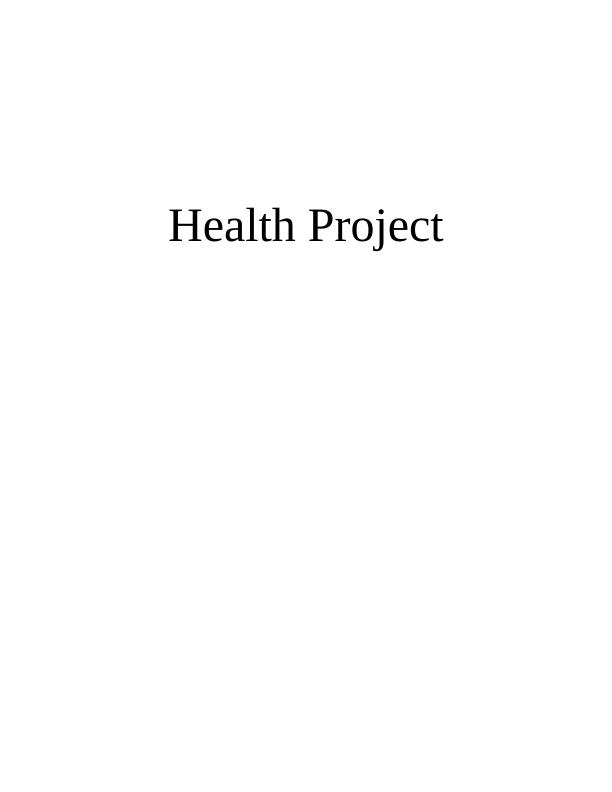
TABLE OF CONTENTS
Table of Contents.............................................................................................................................2
BACKGROUND.............................................................................................................................3
RATIONALE...................................................................................................................................4
OBJECTIVES..................................................................................................................................4
QUESTION......................................................................................................................................4
SCOPE.............................................................................................................................................5
Milestones....................................................................................................................................5
Risks and how they were managed..............................................................................................6
Costs for the project.....................................................................................................................7
METHODS......................................................................................................................................7
Type of Study...............................................................................................................................7
Literature Search..........................................................................................................................8
LITERATURE REVIEW..............................................................................................................12
Current policies on nurse to patient ratios.................................................................................12
Comparison of policies in Australia with legislation of other OECD countries.......................13
Results............................................................................................................................................16
Results of search........................................................................................................................16
Findings of the study..................................................................................................................16
Discussion......................................................................................................................................19
CONCLUSION..............................................................................................................................22
REFERENCES..............................................................................................................................25
Table of Contents.............................................................................................................................2
BACKGROUND.............................................................................................................................3
RATIONALE...................................................................................................................................4
OBJECTIVES..................................................................................................................................4
QUESTION......................................................................................................................................4
SCOPE.............................................................................................................................................5
Milestones....................................................................................................................................5
Risks and how they were managed..............................................................................................6
Costs for the project.....................................................................................................................7
METHODS......................................................................................................................................7
Type of Study...............................................................................................................................7
Literature Search..........................................................................................................................8
LITERATURE REVIEW..............................................................................................................12
Current policies on nurse to patient ratios.................................................................................12
Comparison of policies in Australia with legislation of other OECD countries.......................13
Results............................................................................................................................................16
Results of search........................................................................................................................16
Findings of the study..................................................................................................................16
Discussion......................................................................................................................................19
CONCLUSION..............................................................................................................................22
REFERENCES..............................................................................................................................25
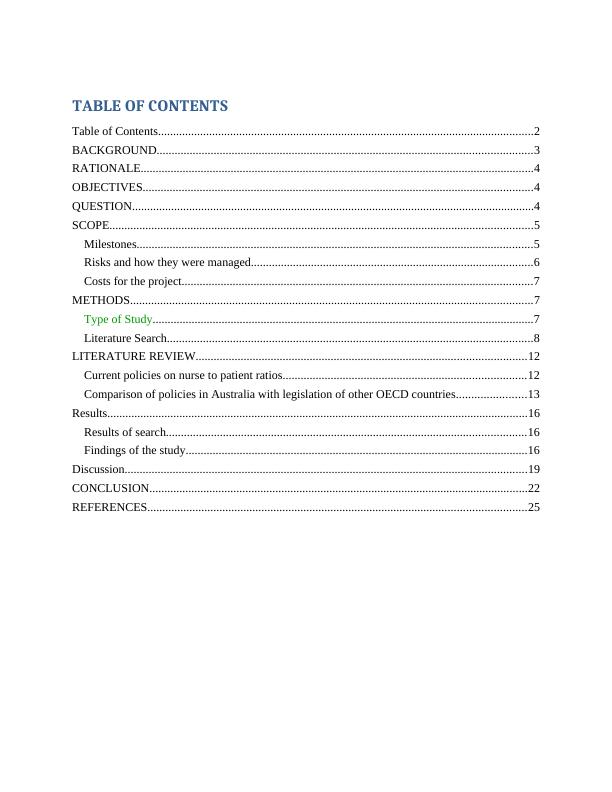
BACKGROUND
A nurse to patient staffing ratio can be defined as a number which describes the total
number of patients which have been assigned to each nurse. Inappropriate nurse to patient
staffing ratios can compromise patient safety and the quality of care that is delivered to the
patients (Kutney-Lee and et.al., 2009). Poor staffing results in patient safety issues which is a
serious concern in healthcare. Patients are being subjected to various medication errors because
the nurses struggle to cope with the workloads (Code red: Our hospitals struggle with workload,
2014). Public and private hospitals in Australia are experiencing a shortage of nurses. This leads
to maldistribution and poor utilisation of nurses. Overworked staff express concerns as they are
failing to detect key injuries. Inappropriate patient ratios can lead to nurses not being able to
provide the level of care that they have been trained and educated to do so. This can effect
nursing morale as well as health of the patient (Wood, 2009). In Australia, there have been
difficulties in recruiting and retaining skilled nurses in both public and private sector because of
unreasonable workloads (Lake and et.al., 2010). Research undertaken by Shekelle, 2013,
indicated that approximately 75 per cent of nurses in hospital wards are considering leaving the
profession. The problem is even more severe in specialised areas such as mental health, aged
care, critical care and midwifery due to acute nursing shortages. (Aiken and et.al., 2012).
It is against the background of nurse shortages and, on occasion, poor nurse to patient
ratios that the question of standards has arisen. These situations indicate the need for right
number and mix of staff for provision of quality care in Australia. Considering the critical
situation prevailing in health care in Australia, it is important to review the current policies
which are in place in both public and private hospitals. Further, there is a need to draw
comparison with legislation from other OECD countries.
It is important to investigate the topic of nurse to patient ratios and current policies in
public and private hospitals in Australia regarding this. In Australia, nursing has been considered
to be a highly fulfilling career (Needleman and et.al., 2011). It is rewarding feeling to be able to
provide relief to the sick and injured. An essential role is played by nurses in delivering health,
aged and general community care in Australia (Schwab and et.al., 2012). Moreover, it has been
estimated that the demand for nurses is expected to increase due to the increase in population and
ageing. It is important to note that minimum staffing ratios are a critical safety standard to
deliver quality care to the service users. It has direct impact on the clinical outcomes. However,
A nurse to patient staffing ratio can be defined as a number which describes the total
number of patients which have been assigned to each nurse. Inappropriate nurse to patient
staffing ratios can compromise patient safety and the quality of care that is delivered to the
patients (Kutney-Lee and et.al., 2009). Poor staffing results in patient safety issues which is a
serious concern in healthcare. Patients are being subjected to various medication errors because
the nurses struggle to cope with the workloads (Code red: Our hospitals struggle with workload,
2014). Public and private hospitals in Australia are experiencing a shortage of nurses. This leads
to maldistribution and poor utilisation of nurses. Overworked staff express concerns as they are
failing to detect key injuries. Inappropriate patient ratios can lead to nurses not being able to
provide the level of care that they have been trained and educated to do so. This can effect
nursing morale as well as health of the patient (Wood, 2009). In Australia, there have been
difficulties in recruiting and retaining skilled nurses in both public and private sector because of
unreasonable workloads (Lake and et.al., 2010). Research undertaken by Shekelle, 2013,
indicated that approximately 75 per cent of nurses in hospital wards are considering leaving the
profession. The problem is even more severe in specialised areas such as mental health, aged
care, critical care and midwifery due to acute nursing shortages. (Aiken and et.al., 2012).
It is against the background of nurse shortages and, on occasion, poor nurse to patient
ratios that the question of standards has arisen. These situations indicate the need for right
number and mix of staff for provision of quality care in Australia. Considering the critical
situation prevailing in health care in Australia, it is important to review the current policies
which are in place in both public and private hospitals. Further, there is a need to draw
comparison with legislation from other OECD countries.
It is important to investigate the topic of nurse to patient ratios and current policies in
public and private hospitals in Australia regarding this. In Australia, nursing has been considered
to be a highly fulfilling career (Needleman and et.al., 2011). It is rewarding feeling to be able to
provide relief to the sick and injured. An essential role is played by nurses in delivering health,
aged and general community care in Australia (Schwab and et.al., 2012). Moreover, it has been
estimated that the demand for nurses is expected to increase due to the increase in population and
ageing. It is important to note that minimum staffing ratios are a critical safety standard to
deliver quality care to the service users. It has direct impact on the clinical outcomes. However,
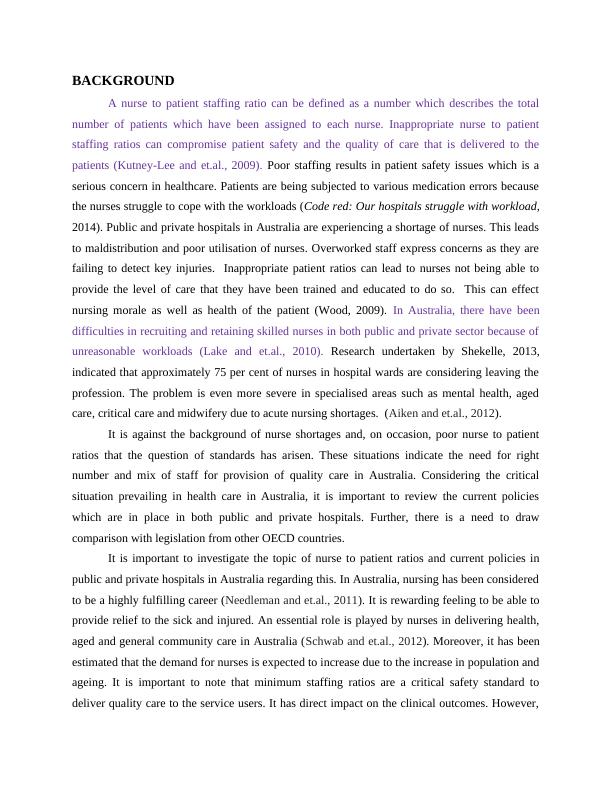
nursing ratios have been a long standing debate in Australia. Inappropriate nurse to patient ratios
make the nurses overburdened (O'Keeffe, 2015). By considering the above mentioned aspects,
the present research project has provided a series of recommendations for the development of a
single national strategy on nurse to patient ratios.
RATIONALE
The rationale behind carrying out the present research project is to understand the crisis
in nursing in Australia and generate awareness about the need to implement standard legislation
on nurse to patient ratios. Nurses in Australia frequently proclaim that they are overworked and
express concern about patient safety. Moreover, they have become so stressed with the current
working conditions that they feel forced to leave the profession (Cook and et.al., 2012). As the
demand for nurses is expected to grow in Australia, there is a need to review current policies in
public and private hospitals regarding nurse to patient ratios and compare them with other OECD
countries. The problem of inappropriate nurse to patient ratios highlights the need to research the
issue and provide recommendations so that a single national strategy can be developed on this
issue.
OBJECTIVES
The objectives of the research project are the following:
To review current policies on nurse to patient ratios
To compare policies in Australia with legislation of other OECD countries
To recommend the development of single national strategy on nurse to patient ratios
QUESTION
The issue that is being addressed is that of inappropriate nurse to patient staffing ratios in
Australia. These have made the nurses overburdened and overworked which has indirectly
compromised on patient safety and quality of care being delivered to the service users in private,
public and aged care in Australia (Penoyer, 2010).
The issue of nurse to patient ratios has come to attention through the availability of much
evidence which indicates that the nurses in Australia are over worked. They have continually
make the nurses overburdened (O'Keeffe, 2015). By considering the above mentioned aspects,
the present research project has provided a series of recommendations for the development of a
single national strategy on nurse to patient ratios.
RATIONALE
The rationale behind carrying out the present research project is to understand the crisis
in nursing in Australia and generate awareness about the need to implement standard legislation
on nurse to patient ratios. Nurses in Australia frequently proclaim that they are overworked and
express concern about patient safety. Moreover, they have become so stressed with the current
working conditions that they feel forced to leave the profession (Cook and et.al., 2012). As the
demand for nurses is expected to grow in Australia, there is a need to review current policies in
public and private hospitals regarding nurse to patient ratios and compare them with other OECD
countries. The problem of inappropriate nurse to patient ratios highlights the need to research the
issue and provide recommendations so that a single national strategy can be developed on this
issue.
OBJECTIVES
The objectives of the research project are the following:
To review current policies on nurse to patient ratios
To compare policies in Australia with legislation of other OECD countries
To recommend the development of single national strategy on nurse to patient ratios
QUESTION
The issue that is being addressed is that of inappropriate nurse to patient staffing ratios in
Australia. These have made the nurses overburdened and overworked which has indirectly
compromised on patient safety and quality of care being delivered to the service users in private,
public and aged care in Australia (Penoyer, 2010).
The issue of nurse to patient ratios has come to attention through the availability of much
evidence which indicates that the nurses in Australia are over worked. They have continually

expressed serious concerns for patient safety. The staff has feared over patient ratios (Duffield
and et.al., 2011). Moreover, health care officials in Australia realized that with greater flexibility
and redistribution of resources, they could make a great health care system. For the past few
days, there has been confusion about ratios and introduction of split shifts. Increase in the patient
demand needs to be matched with the nurse workforce. Demand for health care suffers from
peaks and troughs. This necessitated the need to manage the nursing workload relative to the
demand (Cook and et.al., 2012).
The issue of nurses being overworked has come to attention because there have been
incidents where patient safety had to be compromised and quality care could not be delivered to
the patients. The nurses have been overworked while attempting to assess, medicate and settle
for the patients under their care (Furukawa, Raghu and Shao, 2010). Meanwhile, the rising
demand of health care puts additional work pressure over them. As a result of this the nurses
work without any breaks for long hours. At the end, they are worried that they might have
forgotten something. Due to overcrowding, there is compromised care, high rates of hospital
acquired infections and unnecessary hospital re-admissions.
The following questions have been formulated for the health project:
What are the current policies on nurse to patient ratios as compared to legislation of other
OECD countries?
How nurse to patient ratios and dynamic staffing models can help in addressing the issue
of inappropriate nurse to patient staffing ratios in Australia?
SCOPE
Milestones
The health project on the issue of inappropriate nurse to patient staffing ratios in
Australia comprised of various milestones. Throughout the beginning of the project, emphasis
was laid on identification and detailed analysis of the issue of nurses being overburdened and
overworked in Australia. The problems which result from inappropriate nurse to patient staffing
ratios were also discussed in detail. The project also attempted to cover various current policies
that are in place in both private and public hospitals. It also successfully compared legislations
from other OECD countries. It also provided recommendations for development of a single
national strategy on nurse to patient ratios.
and et.al., 2011). Moreover, health care officials in Australia realized that with greater flexibility
and redistribution of resources, they could make a great health care system. For the past few
days, there has been confusion about ratios and introduction of split shifts. Increase in the patient
demand needs to be matched with the nurse workforce. Demand for health care suffers from
peaks and troughs. This necessitated the need to manage the nursing workload relative to the
demand (Cook and et.al., 2012).
The issue of nurses being overworked has come to attention because there have been
incidents where patient safety had to be compromised and quality care could not be delivered to
the patients. The nurses have been overworked while attempting to assess, medicate and settle
for the patients under their care (Furukawa, Raghu and Shao, 2010). Meanwhile, the rising
demand of health care puts additional work pressure over them. As a result of this the nurses
work without any breaks for long hours. At the end, they are worried that they might have
forgotten something. Due to overcrowding, there is compromised care, high rates of hospital
acquired infections and unnecessary hospital re-admissions.
The following questions have been formulated for the health project:
What are the current policies on nurse to patient ratios as compared to legislation of other
OECD countries?
How nurse to patient ratios and dynamic staffing models can help in addressing the issue
of inappropriate nurse to patient staffing ratios in Australia?
SCOPE
Milestones
The health project on the issue of inappropriate nurse to patient staffing ratios in
Australia comprised of various milestones. Throughout the beginning of the project, emphasis
was laid on identification and detailed analysis of the issue of nurses being overburdened and
overworked in Australia. The problems which result from inappropriate nurse to patient staffing
ratios were also discussed in detail. The project also attempted to cover various current policies
that are in place in both private and public hospitals. It also successfully compared legislations
from other OECD countries. It also provided recommendations for development of a single
national strategy on nurse to patient ratios.
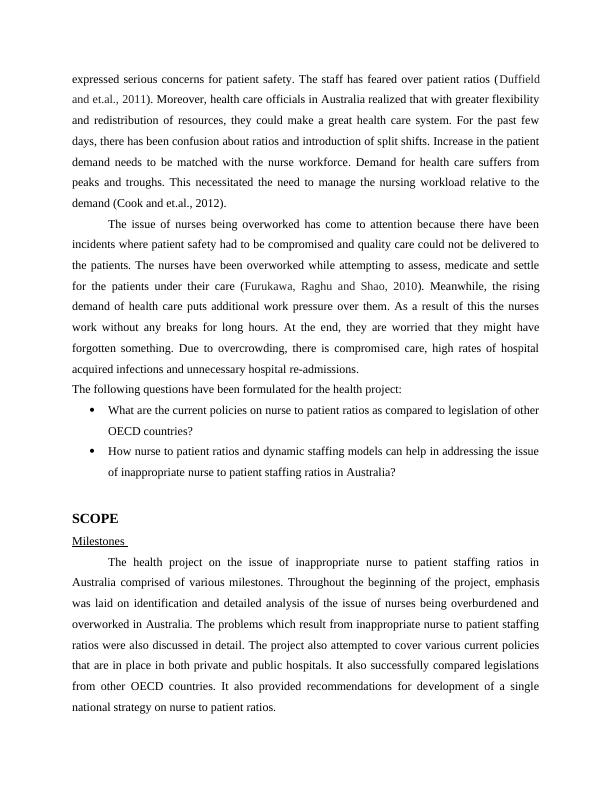
Hence, the health project was more focused upon policies and legislations for appropriate
nurse to patient staffing ratios. However, it did not cover the reasons behind inappropriate ratios.
Also, implementation of single national strategy to nurse patient ratios could not be addressed as
the project focused upon development of this strategy.
The health project will be undertaken over a period of 11 weeks. This will be from 30
November to 15 February. The following are the milestones for the project. Background,
rationale and objectives were achieved by 24 December. Following this were question, scope
definition, design and methodology which were completed by 31 December. Literature review
was undertaken on 8 January. Results section will be done by 25 January. This will be followed
by discussion section on 2 February. Conclusion will be finished by the date 10 February. Lastly,
completion of final report will take place by the date 15 February.
In the first week of December, the original search for the project was carried out. This
involved electronic search through various e-databases such as the Cochrane Library, Science
direct, Medline etc. All the study material was restricted to a period of 2005 – 2015 years. After
evaluating the journal articles from the various databases, 7 articles were selected to be include
in the project. Inclusion and exclusion criteria guided the evaluation of articles. Only those
journal articles were included which were published in English language. Articles in any other
language were excluded from the project a,long with those studies that were published prior to
the year 2005.
Risks and how they were managed
Various risks were associated with carrying out the present health project on
inappropriate nurse to patient staffing ratios. These were associated with fraud in collection of
data, loss of data due to inadequate back – up procedures, serious breach of ethical
considerations etc. These risks were managed by taking appropriate steps in the right direction.
The researcher adopted reliable methods for collection of data. Also, authentic sources of data
were used for collection. Required actions were taken for appropriate storage of data which not
only involved back-up procedures but also checked unauthorized access to the data. Ethical
norms and rules were followed by the researcher which ensured that the project is sound on
ethical grounds.
nurse to patient staffing ratios. However, it did not cover the reasons behind inappropriate ratios.
Also, implementation of single national strategy to nurse patient ratios could not be addressed as
the project focused upon development of this strategy.
The health project will be undertaken over a period of 11 weeks. This will be from 30
November to 15 February. The following are the milestones for the project. Background,
rationale and objectives were achieved by 24 December. Following this were question, scope
definition, design and methodology which were completed by 31 December. Literature review
was undertaken on 8 January. Results section will be done by 25 January. This will be followed
by discussion section on 2 February. Conclusion will be finished by the date 10 February. Lastly,
completion of final report will take place by the date 15 February.
In the first week of December, the original search for the project was carried out. This
involved electronic search through various e-databases such as the Cochrane Library, Science
direct, Medline etc. All the study material was restricted to a period of 2005 – 2015 years. After
evaluating the journal articles from the various databases, 7 articles were selected to be include
in the project. Inclusion and exclusion criteria guided the evaluation of articles. Only those
journal articles were included which were published in English language. Articles in any other
language were excluded from the project a,long with those studies that were published prior to
the year 2005.
Risks and how they were managed
Various risks were associated with carrying out the present health project on
inappropriate nurse to patient staffing ratios. These were associated with fraud in collection of
data, loss of data due to inadequate back – up procedures, serious breach of ethical
considerations etc. These risks were managed by taking appropriate steps in the right direction.
The researcher adopted reliable methods for collection of data. Also, authentic sources of data
were used for collection. Required actions were taken for appropriate storage of data which not
only involved back-up procedures but also checked unauthorized access to the data. Ethical
norms and rules were followed by the researcher which ensured that the project is sound on
ethical grounds.
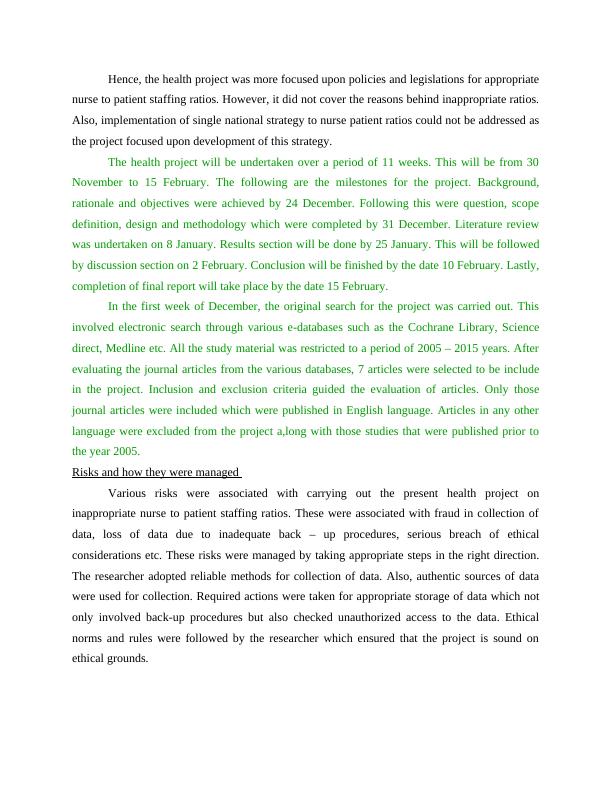
End of preview
Want to access all the pages? Upload your documents or become a member.
Related Documents
Patient’s Ratio to Nurses in Aged Care Settingslg...
|10
|801
|374
Nursing Leadership: Mitigating the Problem of Inadequate Nurse to Patient Ratio in Aged Care Sectorlg...
|6
|1125
|144
Nurse Staffing Regulationslg...
|5
|1152
|199
Impact of Assistant Practitioners in Critical Care Unitslg...
|27
|9504
|38
Research Legislation - Nursing Carelg...
|3
|417
|42
Nursing turnover issue is multifacetedlg...
|8
|2088
|19
